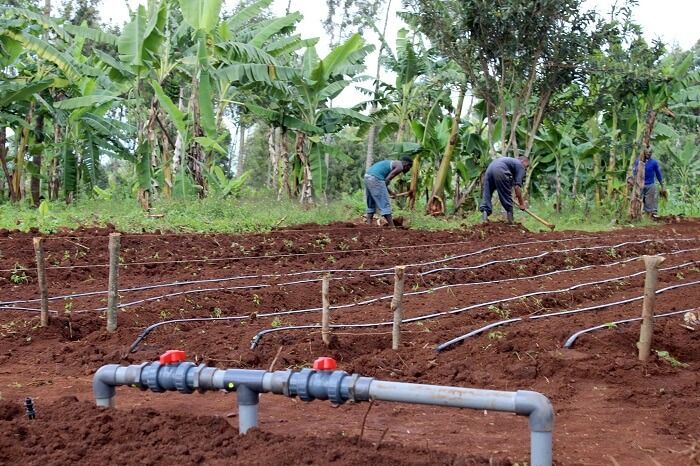Irrigation is the critical input in the agrarian method which superintends the amount of water drizzling towards the root shrubs with regular interregnum. It artificially bestows the water by fulfilling the demand to safeguard the fast, nutritious growth of crops. People mostly need deluge when there is drought or no rain. The derivation from where we can collect irrigation water can be rivers, lakes, wells, canals, etc. Mostly in agricultural countries, many factors like chemical fertilizers, yielding, industrial growth as well as socio-economic enlivens pivot on irrigation. The current water reservoirs can cover 50% facet worldwide by irrigation. There are different types of irrigation- surface, sprinkler, drip, center pivot, and manual irrigation.
The various types of irrigation come with their advantages and disadvantages.

Irrigation in fertile lands for growing crops. Source: SunCulture
Advantages of Irrigation
Followings are the major advantages of irrigation systems.
- Irrigation helps to maintain the condensation of the loam.
- It provides mineral as well as other nutrition by the assimilation from the mold.
- Irrigation is one of the most feasible ways to grow cash crops like sugarcane, tobacco, etc.
- As people are dependant on irrigation channels, there is now an extensive irrigation system which people are using as a mean of their communication
- It helps to preserve the structure of the topsoil
- By eliminating the deficiency of water, Irrigation manages to give fast manufacturing
- The more production rate intensifies, the more living standard of the farmer increases
- Canal and irrigation water seeps through the soil and elevates the water table. This is desirable in desiccated and semiarid zones
- At many places, the irrigation serves as the only water source.
- Irrigation helps to make the cash flow of a country profound with the massive production of crops
- It helps the landowners by the monetary increment of fertile lands
- People in rural areas use irrigated water for household chores like- dishwashing, bathing.
- Irrigation helps to improve the yielding.
- The irrigation waterways can be utilized to produce hydroelectric power
- As people are more prone to irrigation now, colossal irrigation channel construction is assisting the people to be employed known as relief workers.
- It helps to prevent the disease of weeds
- It acts as a shield against famine
- Prolonged irrigation is used for navigational impetus sometimes
- The banks of the irrigation channels can be wielded to prevent deforestation and improve contexture status. {adselite}
Disadvantages of Irrigation
Followings are the major disadvantages of irrigation systems.
- Irrigation sometimes creates unrestrained excretion and percolation of water throughout the whole passage.
- The overflowing irrigated water gives insects a place to make their habitat which is harmful to surroundings giving rise to various diseases.
- As irrigated water helps to lessen the inversion, sometimes it turns the area into a wet and sweaty surface. Immoderate irrigation clogs specific area by raising the water.
- While constructing the colossal irrigation waterways, people lose their residential and commercial lands.
- Not every time irrigation is affordable. The embryonic value of irrigation is quite inflated, and people end up paying a lot of imposed taxes.
- Irrigation becomes an obstacle in the path of free devours during the rainy season.
- Careless and over-irrigation can lead to salt efflorescence.

